What do we know about communities of organisms thriving around vents and seeps on the Arctic sea floor?
Vent and Seep Communities
on the Arctic Seafloor
Peter Vogt
Naval Research Laboratory
Washington, DC
Email: vogt@qur.nrl.navy.mil
This essay will
also appear in a forthcoming report of the Arctic Council's working
group on Conservation of Arctic Flora and Fauna (CAFF).
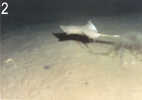 |
| Photograph of a starry skate and an asteroid starfish (center left) from Fram Strait. |
Deep, under perpetual ice cover, with reduced photosynthesis and thus little organic matter coming from above, the sea floor of the central Arctic Ocean is a marine desert, its life more sparse than in other ocean basins. But photosynthesis is not the only basis for life: locally, methane and hydrogen sulfide seep from the ocean floor, supporting dense oases of organisms that depend on bacteria able to consume these chemicals. Such "chemosynthetic" life does not directly depend on sunlight and can thrive even at great ocean depths.
Two basic kinds of oases are now known from the oceans. Hot vents, first discovered in 1977, are now known from several places along the Mid-Oceanic Ridge. These seafloor geysers belch out seawater heated up to 400°C and laden with nutritious chemicals. Dramatic colonies of large clams, giant tubeworms, and other strange life-forms have been discovered at some hot vents.
The second broad category of chemosynthetic oasis is the "cold seep,"* which usually involves the upward seepage of methane dissolved in water or as small bubbles. Mud volcanoes and related cold-seep features form over great sediment accumulations in which bacteria digest buried organic matter, producing methane as a waste product. Specially evolved bacteria oxidize the methane, forming the foundation of a food chain. Different bacteria have evolved to oxidize the foul-smelling hydrogen sulfide, itself the waste product of yet other bacteria living below the ocean floor, which oxidize sulfate ions of seawater origin. The conspicuous and, by bacteria standards, large sulfur bacteria (Beggiatoa spp.) form thin, snow-like mats on the seafloor where seepage takes place. Bacterial mats form at hot vents also, but Beggiatoa is common at cool oceanic seeps and some non-seep environments where hydrogen sulfide rises close to the seafloor and oxygen is present in the water.
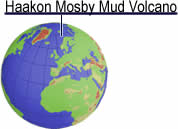 |
| Find out more from the U.S. Navy All Hands web site, April 1998 |
Neither hot nor cold vents had been found in the Arctic until,
in 1995 and 1996, a team of American, Norwegian, and Russian scientists
discovered an active cold-seep mud volcano on the continental margin
west of the Barents Sea, at 72°N. The Haakon Mosby mud volcano is
about a kilometer in diameter, and stands only a few meters high
in water 1250 meters deep. The mud volcano has a patchy white cover
of sulfur bacteria mats (which few creatures eat), and is home to
a diverse community of creatures whose food web is based is methane-consuming
bacteria. Whereas the mud volcano underlies a presently ice-free
part of the
Arctic, there is no reason not to expect discovery of similar features
in the ice-covered
Arctic Ocean.
In the summer of 1998, scientists inspected the Haakon Mosby mud volcano first hand, aboard the Russian Mir submersibles that had been used to explore the Titanic. The submersible sampled bottom sediments and used a "slurp gun" to suck in unsuspecting bottom fish in order to study them and augment museum collections. Two species of small tubeworms were found on the mud volcano, one of them previously known only from the Antarctic. A number of small, sand-sized animal species sifted from the seafloor mud of the mud volcano also depend on chemosynthesis.
 |
| Graphic
and caption text from the U.S.
Navy All Hands web site, April
1998. "While exploring the Haakon Mosby Mud Volcano, NRL researchers discovered several 'new' species of marine life. In addition to 'vermicelli-spaghetti-like' tubeworms, scientists found more than 20 new species of meiofauna (sand-grain-sized animals) and a bottom-fish density more than one hundred times that found on the normal seafloor. Photosynthesis does not provide the basis for this deep ocean food chain, methane-based chemosynthesis does. The fish, dominated by a species of eelpout measuring the length of a pen, congregate around the mud volcano much like seagulls do at the local dump." |
The most common fish found were scalebelly eelpout (Lycoides squamiventer). Stomach contents of these fish included tubeworms and other chemosynthesis-dependent creatures, confirming that the fish are indeed part of the local ecosystem. The eelpout was several hundred times more abundant on the mud volcano than elsewhere on the bottom of the surrounding Greenland-Norwegian Sea, and is apparently attracted to the mud volcano by its abundant food supplies.
A variety of other fish were photographed, but not captured, on the mud volcano surface. Conspicuous are several species of skate, which probably form the top of the local food chain by consuming smaller bottom fish like eelpout. The habit eelpout have of lying inside small bottom depressions may be their way of escaping detection and consumption by skates searching for prey. The largest predator fish in these cold waters is the Greenland shark, but scientists aboard the Mir submersibles were not lucky enough to glimpse this rare animal.
The search for hot vents along the Arctic extension of the Mid-Oceanic Ridge, which separates the North American and Eurasian plates, has just begun. To date, the northernmost known hot vent is just north of Iceland, in a shallow-water environment atypical of hot vents studied elsewhere. There is every reason to expect such vents to exist farther north, probably with some organisms new to science, or at least distinct from those found farther south.
Gallery — Click the image to see larger image with taxonomy provided by Dr. M. Eric Anderson, Senior Marine Ichthyologist, JLB Smith Institute of Ichthyology, Grahamstown, South Africa.
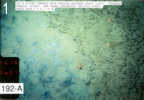 |
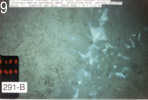 |
Scenes from the Haakon Mosby mud volcano, collected from a deep-tow camera sled. Photographs from a 1996 research cruise on the Russian research vessel NIS PROFESSOR LOGACHEV, with Chief Scientists Dr. Peter Vogt (Naval Research Laboratory, Washington DC), Dr. Georgiy Cherkashev (VNIIOkeangeologiya, St. Petersburg, Russia), and Prof. Kathleen Crane (Hunter College, NY and Naval Research Laboratory, Washington DC). Photo numbers are the CAFF Report numbers.
 |
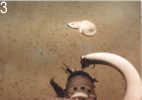 |
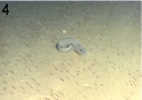 |
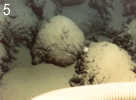 |
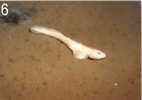 |
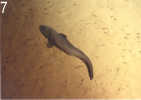 |
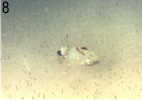 |
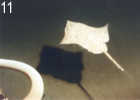 |
 |
Photo #5 shows pillow basalts in the Knipovich Ridge rift valley. The others were taken in two methane seep environments: (1) the Haakon Mosby mud volcano, and some "pockmarks" (seeps) on Vestnesa Ridge, and (2) Fram Strait (between Greenland and Spitsbergen). Photographs are from a 1998 expedition using MIR submersibles launched from the support ship NIS MSTSLAV KELDYSH. Chief scientists on that expedition were: Dr. Peter Vogt (Naval Research Laboratory, Washington DC), Dr. Juergen Mienert (formerly Geomar, Germany and presently at Univ. of Tromsoe, Norway), Prof. Kathleen Crane (Hunter College, NY and NRL), Prof. Eirik Sundvor, (Univ. of Bergen, Norway), and Dr. Anatoly Sagalevitch (Head, Manned Submersible Program, Shirshov Institute of Oceanology, Moscow). Photo numbers are the CAFF Report numbers.
Related Links
Russian research vessel discovers mud volcano
http://www.pao.nrl.navy.mil/rel-96/127-96r.html
Haakon Mosby Mud Volcano (scroll half-way down the page to find
this article)
http://www.mediacen.navy.mil/pubs/allhands/apr98/Aprpg20.htm
Haakon Mosby Mud Volcano: A Warm Methane Seep With Seafloor Hydrates
and Chemosyntheses-bas
http://www.agu.org/
Deep Sea Vents article from National Geographic Magazine, October 6, 2000
References
Herman, Y. 1989. The Arctic Seas—climatology, oceanography, geology, and biology. New York: Van Nostrand Reinhold Co. 888p.
Humphris, S.L., R.A. Zierenberg, and I. Mullineaux 1995. Seafloor hydrothermal systems. Geophysical Monograph 91. Washington: American Geophysical Union. 466 p.
Milkov, A., P. Vogt, G. Cherkashev, G. Ginsburg, N. Chernova, and A. Andriashev. 1999. Sea-floor terrains of Haakon Mosby mud volcano as surveyed by deep-tow video and still photography. Geomarine Letters 19: 38-47.
Pimenov, N., A. Savvichev, I. Rusanov, A. Lein, A. Egorov, A. Gebruk, L. Moskalev, and P. Vogt. 1999. Microbial processes of carbon cycle as the base of food chain of Haakon Mosby mud volcano benthic community. Geomarine Letters 19: 89-96.
Vogt, P.R., J. Gardner, and K. Crane. 1999. The Norwegian-Barents-Svalbard (NBS) continental margin: introducing a natural laboratory of mass wasting, hydrates, and ascent of sediment, pore water, and methane. Geomarine Letters 19: 2-21.
*The term "cold seep" has arisen in the literature to distinguish it from hot vents on the active (volcanic) spreading plate boundary. A more accurate term might be "slightly warm" or "lukewarm", because the seepage consists of porewater, gas and mud which "remember" the warmth of the earth beneath the seafloor from which they rise. Temperatures inside the earth increase with depth inside the earth, even without volcanic activity. Return to article here.




